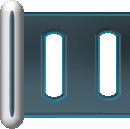|
When dolphin(dauphin) of the Atlantic Ocean splits the surface of the Ocean, its body waves and takes literally the bodies of water which surround him(it) as support points to trot forwards. Making it, he(it) creates around him of numerous bustles which oppose his(her,its) progress. However, when he(it) is totally submerged, it is capable of modifying the relief of the skin to eliminate the majority of the turbulences. In a speed of normal cruise, the superficial tension of the water (the effect of surface) burdens only in a insignificant way the energy budget which the animal dedicates to its drive. In big speed, the situation is different and the consumption of energy becomes considerable: so dolphin(dauphin) has to fight constantly against the bustles which form throughout his(her,its) body and which burden heavily his(her,its) energy budget. In the Ocean, the animals (« that they are big or small ») see their speed reduced by two different forces: the resistance due to the forms and the friction. The first one is strictly connected to the hydrodynamics and to the prospinning. The force of friction, as for her(it), depends essentially of « of the polite » on the épidermique coat(layer) external. The speed reached(affected) by dolphins(dauphins) was always an object of surprise for the sailors: 15 in 20 knots are normal speeds and we even observed points of 30 knots and advantages. Knots: equivalent to a uniform speed which corresponds to 1 thousand per hour and being worth 1852/3600 metres per hour. THE PROSPINNINGS The drainage of the water can be laminaire (ribband), turbulent (irregular), or intermediate. The drainage laminaire determines the weakest resistance and the turbulent regime the resistance more hardly. Practically, the bustle created by the body of a fish or the hull(shell) of a vessel produce an intermediate stream. The best profiled bodies determine a stream almost laminaire, and the speed in which they move is directly bound(connected) to the perfection of their curve. The turbulence is careful when the film of water in immediate contact with the body in movement (coat(layer) - limit) begin to become unstable. This instability is largely inevitable when it is about stiff hulls(shells) of vessel conceived by the man. But if we manage to master the turbulence in the limit coat(layer), the drainage almost laminaire can be maintained on all the surface of the body. It seems that Fishes and the maritime Mammals - dolphin(dauphin) maybe more than the others - are endowed with such a stabilizing mechanism. By modifying constantly their shape to make marry in their body the direction(management) of the current, they are capable of reaching(affecting) big speeds by exceeding much less energy than their human artificial retorts, so faithful as they appear.
This shape separates easily toilets, drank the later ( posterior ) surface widened by this volume determines force of delay and has powerful has very engrave(burn) behind turbulence. B-Volume Thin and lengthened Profiled in torpedo: Fishes characteristic spindle-shaped, barracuda, shark, minimal engender by swimming turbulences The water slides one their body in thin coats ( layers ) and creates only has weak force of delay behind. C-Sélection Truncated (cone inverted with regard to the first plan) It is one of the least effective forms. Not only she(it) penetrates badly into waters, but still into her(it) determine strong turbulences. D-Corps Moderately lengthened and widened(Moderately stretched out and widened) He(It) arouses a little more turbulences than a really spindle-shaped body, but these can be reduced by some. |



